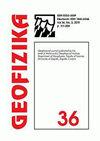Assessing vulnerability for inhabitants of Dhaka City considering flood-hazard exposure
IF 1.1
4区 地球科学
Q4 GEOCHEMISTRY & GEOPHYSICS
引用次数: 10
Abstract
Global flood hazard is gradually increasing. Though it is impossible to avoid them, losses and damage of hazards (e.g., floods, cyclones, and earthquakes) could be efficiently reduced by reducing household vulnerability with appropriate measures. This study aims to quantitatively measure the household vulnerability of flood hazards as a mitigation tool. It also proposed a unique approach to quantify flood-hazard household vulnerability, and shows its application in the flood prone city of Dhaka as an example case. Data were collected from both slum and non-slum areas to cover the entire urban habitat, and to compare their level of flood vulnerability. A total of 300 households were surveyed by structured questionnaire on the basis of five factors (economic, social, environmental, structural, and institutional) of flood vulnerability. The analytical hierarchy process (AHP) was applied to measure individual household vulnerability scores by using the relative weightage of variables and indicators with proper standardisation. Analytical results demonstrated that 63.06% slum and 20.02% non-slum households were highly vulnerable to floods. In addition, this paper determined and assessed responsible factors for household flood vulnerability in Dhaka. For structural vulnerability, results exhibited that 82% of slum households were highly vulnerable, and 95.3% of non-slum households were moderately vulnerable. Socially, 67.3% of slum and 78.7% of non-slum households were moderately and low-vulnerable. The majority of slum and non-slum households (84% and 59.3%, respectively) showed high and moderate vulnerability with respect to economic vulnerability. Moreover, 69.3% of slum and 65.3% of nonslum household institutional vulnerability levels were high. Of slum inhabitants, 63.3% were environmentally at high risk, and 78% of non-slum habitats were in the low-vulnerability category. However, as an effective tool to measure location-specific vulnerability, it is applicable for the measuring vulnerability of other cities in the world with proper customisation. On the basis of this study, future research could be conducted with more factors, variables, and indicators of human vulnerability to natural or artificial hazards/disasters. Future work may provide a better reflection of the vulnerability status of single/multiple hazard(s)/disaster(s).考虑洪灾风险,评估达卡市居民的脆弱性
全球洪水灾害正在逐渐增加。虽然不可能避免灾害,但通过采取适当措施减少家庭脆弱性,可以有效地减少灾害(如洪水、旋风和地震)的损失和损害。本研究旨在定量测量家庭对洪水灾害的脆弱性,作为减灾工具。它还提出了一种独特的方法来量化洪水灾害家庭脆弱性,并以洪水易发城市达卡为例展示了其应用。从贫民窟和非贫民窟地区收集数据,以覆盖整个城市栖息地,并比较其易受洪水影响的程度。基于经济、社会、环境、结构和制度五个因素对300户家庭进行了结构化问卷调查。采用层次分析法(AHP),对各变量和指标进行相对权重的标准化,测量个体家庭脆弱性得分。分析结果表明,63.06%的贫民窟家庭和20.02%的非贫民窟家庭极易受到洪水的影响。此外,本文还确定和评估了达卡地区家庭洪水脆弱性的责任因素。对于结构脆弱性,结果显示82%的贫民窟家庭是高度脆弱的,95.3%的非贫民窟家庭是中等脆弱的。从社会角度看,67.3%的贫民窟家庭和78.7%的非贫民窟家庭属于中等和低脆弱性家庭。大多数贫民窟和非贫民窟家庭(分别为84%和59.3%)在经济脆弱性方面表现出高度和中度脆弱性。此外,69.3%的贫民窟家庭和65.3%的非贫民窟家庭机构脆弱性水平较高。在贫民窟居民中,63.3%的人处于环境高风险中,78%的非贫民窟居民属于低脆弱性类别。但是,作为一种测量特定地点脆弱性的有效工具,在适当定制的情况下,它适用于全球其他城市的脆弱性测量。在本研究的基础上,未来的研究可以对人类对自然或人为灾害的脆弱性进行更多的因素、变量和指标的研究。未来的工作可能会更好地反映单个/多个危害/灾难的脆弱性状态。
本文章由计算机程序翻译,如有差异,请以英文原文为准。
求助全文
约1分钟内获得全文
求助全文
来源期刊

Geofizika
地学-地球化学与地球物理
CiteScore
1.60
自引率
0.00%
发文量
17
审稿时长
>12 weeks
期刊介绍:
The Geofizika journal succeeds the Papers series (Radovi), which has been published since 1923 at the Geophysical Institute in Zagreb (current the Department of Geophysics, Faculty of Science, University of Zagreb).
Geofizika publishes contributions dealing with physics of the atmosphere, the sea and the Earth''s interior.
 求助内容:
求助内容: 应助结果提醒方式:
应助结果提醒方式:


